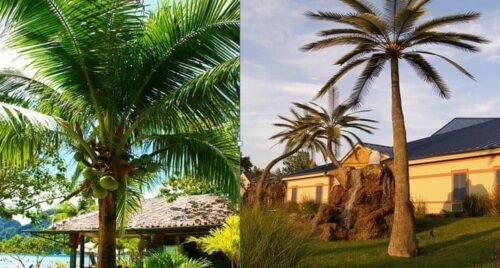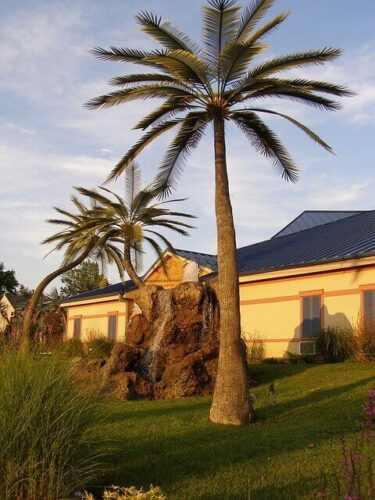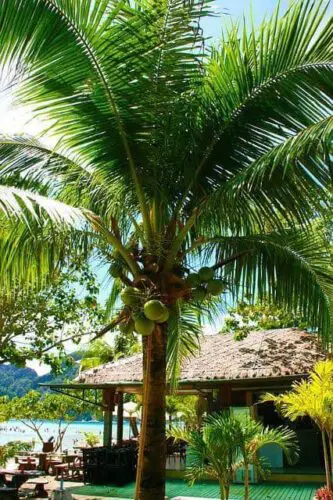Do you know the difference between Coconut Trees vs Palm Trees? Most people do not even know about it, and some are confused about coconut tree vs palm tree. The coconut tree is different from the palm tree. However, it is strange for the majority to understand how it is possible when coconut is a type of palm tree. There are various palm trees, but only one species produces coconuts. It is essential to learn about both in detail to understand this difference. Read this article till the end to understand the difference.
Coconut Trees vs Palm Trees – The most common difference is their leaves. Palm tree leaves look fan-shaped while the leaves on coconut trees are open and wide. Palm trees won’t be producing coconuts but coconut is more like a palm tree which produces coconuts. Coconut is rich in many minerals including manganese, copper and iron, basically a super water. Palms on the other hand is famous for its palmolein oil which is used in packed foods and is highly unhealthy.
Areas which are near the beaches, oceans have an advantage over the psalms because the trees are easily formed geographically. I myself whenever I go to a place which has coastal areas, the land is automatically rich in palms, whether it is coconut or any other. The agriculture of these palms is easy and long profitable.

Now let’s find out one by one about what are these and what is the difference between palm tree and coconut tree.
Comparison Table between Palm Tree and Coconut Tree:
| Palm Tree | Coconut Tree | |
| Leaves Shape | Fan-like Shape With Larger Size | Open and Wide with smaller Size |
| Uses | Palmolein Oil for Processed Food | Coconut Oil, Coconuts water |
| Lifespan | 150 years | 80 years |
| Growth Rate | 6 feet(72 inches) per year | 11-35 inches(2 feet) per year |
| Light Requirements | Full to partial shade | Full Sun |
| Water | Excess water needs but tolerate dry conditions | Daily Water Need but can handle Dry spells once mature. |
| Mature Size | 200 feet, vary from variety to variety | 100 feet |
| Caring Needs | Easy If Conditions Met | Easy to difficult based on variety |
| Root Length | more than 35 inches | more than 1cm |
What are Palm Trees?

A palm tree is a group of plants that contains the palm tree class in some characteristics. The majority of the people imagine a sunny beach setting at the sight of the palm tree. It is a type of plant that grows in different environments. They have over 2500 species, and coconut is one of them. No two species are the same. They have distinction due to their various characteristics. Due to these properties, it becomes easy to differentiate them from other palm trees. Similar is the case with the coconut trees. All coconut trees are palm trees, but all palm trees cannot bear coconut fruit.
These are evergreen plants and grow in the form of lianas, woody vines, trees, and shrubs. The Arecaceae family belongs to them. You can see this family all around the globe, from rainforests to deserts.
How many types of palm trees are there?
Most of the types of the palm trees, including coconut trees, are found in several tropical areas. In the cold environment, they can survive surprisingly very well. However, it does not mean they are the plants to grow in cool places. They do not come in the category of trees. They are plants, but they look similar to trees.
Moreover, they can vary in height and are tall. Coconut trees are not exceptional in this characteristic. A coconut tree can grow fifty to a hundred feet. They come in the taller species, but they do not come in the class of the tallest species.
Fruit Bearing Palm Trees
Some palm trees bear flowers, and some bear fruits. Some of the fruit-bearing palm trees are here.
Date Palm
They produce dates and are native to Iraq and Gulf areas. They produce sweet edible fruits, and it is different in quality, size, and color. You can view these trees in the Middle East, Saudi Arabia, and other states. There are numerous categories and types of dates as per the difference in the region. It contains pinnate leaves, and its height can be 75 feet. This feature depends on the species.
High-plateau Coconut Palm
It is a coconut palm tree that belongs to Arecaceae. It thrives best in cooler temperatures and resembles the coconut palm. This tree is native to Madagascar, and the plant grows at an elevation of 1000 meters approximately. The other types of coconut plants grow very well in a warm climate. They need a tropical climate to produce a healthy yield. Therefore, you will find them in the coastal areas or rain forests.
Queen Palm
They are crowned and single-trunked with the bright pinnate leaves. You can identify them with the beautiful canopy that their leaves form. In warm areas, the tree serves well for landscaping. Queen palm produces bright orange dates.
African oil palm
Palm oil is very famous around the globe, and there is a high demand for it. With 66 feet in height, it is native to West Africa. However, West Indies, Central America, Malaysia, and Sri Lanka provide habitat to these plants. You can identify it with its leaves spanning over 10 to 16 feet. Its bright red fruit contains a single seed. It is rich in oil, so those countries export the oil and earn foreign exchange.
Identification of Palm Trees
You need to understand the key for coconut tree vs palm tree. The key to identifying this class is the style of its leaves. It contains two types of leaves such as pinnate and palmate leaves. Pinnate leaves are similar to feathers on both sides of the stem. Palmate leaves grow at the end of the stem-like hands. Moreover, you can identify palm trees with their leaf style and height. The leaves take the shape of fans with the structure sections that extend outside from the main stem.
They normally grow 10 feet, but the tallest palm tree can grow up to 197 feet. Well, the height and growth level varies from species to species. Similar is the case with the trunk size. Some of them have dwarfed trunks, and some have thick. Some of its species bear scaly trunks, and some have tall. They love habitats with a subtropical or tropical climate. It is simple to grow them in a pot and on the ground.
Acai fruit, betel nuts, and dates grow on the palm fruits. Similarly, a type of palm tree bears coconut fruit. Palm oil comes from these trees as well.
Sago Palm Tree Real Live Plant – Shop Now
Sago Palm Live Plant in a 10 Inch – Shop Now
What is Coconut Tree?

Cocos Nucifera is the scientific name for Coconut palm. It is the only Palm tree species that bears coconuts. However, many other sub-varieties of coconut trees exist. The coconut bearing palm tree grows to a height of 100 feet tall. Their trunks are lean, long, and contain a smooth texture. You can identify them by their pinnate leaves with yellow flowers.
The coconut tree starts producing fruits at four to five years old. A fully mature coconut is prepared in six months. In a year, a tree bears up to 25 coconuts. The young fruits are sweeter than the ripened ones. They have higher demand as compared to the matured fruits. Young fruits have more minerals and water, so people use their water.
How does coconut differ from other palms?
To learn the differences between coconut tree vs palm tree, you need to be more focused here. There is a lot of variation from one species to another of Palm trees. For instance, the foxtail palm is entirely different from the date palm. Similarly, coconut palms look different from each other. However, date and coconut palms are quite similar to each other. There are some keys through which we identify the coconut tree and differ it from other palm trees. You can identify those by their appearance and look. Learn more about it in the below lines.
- Height of the Coconut tree
There are two categories of coconut trees, and those are dwarf and tall. The dwarf trees can reach up to 60 feet in height. The tall varieties grow up to 98 feet in height. Both the categories carry different subtypes growing in various regions with a variety of fruits in shape, size, and color. Jamaica Tall and Panama Tall are examples of tall varieties. On the other hand, dwarf cultivars contain Fiji and Malayan.
- Stem Appearance
The stem is the first difference in the stem of the coconut tree. In general, palm trees contain a scaly sort of trunk. It is rough and textured. You will feel plenty of lumps and bumps if you run your hand down it. The palm tree sheds leaves and grows tall. The part of the leaves attached to the tree contains a fibrous and tough structure. It drops off and includes solidity and stability to the stem of the palm tree. The tree grows quickly and easily over time until it forms a type of bark.
Palm tree gains more and lumps when its leaves fall since it grows foliage and sheds the leaves. This factor makes the appearance of the trees tiered and gives them a rough and rugged stem. However, this stem is supportive of leaves.
Focusing on the coconut tree vs palm tree, the coconut palm tree contains a less scaly trunk. It is smoother as compared to the other palm plants. Coconut bears a thinner stem that is supportive of leaves. The palm trees are thin and tall in appearance. You can identify them by touching their trunk as it does not contain bumps and lumps.
- Fruits
If you are strolling on the beach and looking for the palm tree, this technique will work during the fruit season. It starts producing fruit in 4 to 5 years, and it takes six months to produce a matured fruit. However, the young share a more pleasant and refreshing flavor and water.
The major difference between both types is the fruit. The fruits are different from each other. Coconuts are the drupes, not the nuts. During the season, the bearing coconut on the tree is the major indicator of coconut tree vs palm tree. In this way, one can easily identify the coconut tree. However, a long and slim stem is one of the most common indicators.
What does coconut fruit look like?
The majority of the people think that it looks like a nut. It is not a nut, and the young and ripened fruit are different from each other. The unripe one looks very different and huge in green color. The young ones are big and refreshing in flavor. They are rich in water, and this water turns into coconut flesh as time goes on. The matured one is smaller and brown. It contains more flesh and less water. They are not easy to access as they are found on the top of the tree under the umbrella of the leaves. You can view them with your eyes.
Some other palm trees bear fruit like date palms. They are different from coconut in size and shape. Dates are very small, sweet, and tasty. The seed is inside the flesh. On the tree, they are found in the form of bunches.
- Leaves
One can identify the plant with the leaves as well. There are two types of leaves, and coconut contains quite wider ones. On the other hand, the palms have narrow ones. The coconut leaves are fan-like, and they are very easy to differentiate from others.
- Root system
A coconut palm contains a unique root system, and it covers the surface as per the height of the tree. Moreover, they are not deep underground. There are no taproots. In this way, hurricanes and winds uproot the plant easily. Other palms have deeper roots underground. It depends on their size and type.
Coconut Tree 12 inch – Shop Now
Coconut Tree 72 inch – Shop Now
Identification of Coconut Trees vs Palm Trees
The quick comparisons between both the trees will help you understand the differences. Learn more about it in the below lines here.
Coconut Tree
One can find some differences due to the dissimilar appearance of the coconut tree from the others.
- Prefers moist, hot, warm climates
- Grows in tropical regions
- Lifespan is sixty to eight years
- Deep-rooted
- Bears fruit
- Wide-shaped leaves
Palm Trees
- Prefers tropical and warm climates
- The life span is about 150 years
- The average life of a tree is 70 to 100 years
- Roots are firm and spread
- Produce oil
- Some palm trees bear fruits, not coconut, and some bear flowers
- Leaves are fan-shaped
How to Recognize Coconut Trees vs Palm Trees?
There are many methods to recognize both types. Have a look at these quick notes to understand the difference.
Coconut Trees
- Coconut trees contain textured and slender trunk that appears in light shade
- Taller trees grow up to 100 feet, and the dwarf can grow up to 40 to 60 feet
- The fibrous woody strands cover the fruits
- The trunk is slim and long
- The tree contains a thick base
- Feather-shaped wide leaves
Palm Trees
They are not much similar to each other. All the palm trees are differentiated based on their specific characteristics.
- They come with the multi-trunk and single trunk
- The trunk can be rough and bumpy when touched
- Dwarf Palm trees are fat and have short trunks
- They contain pinnate fronds
For the majority of the people living near tropical areas or coastal areas, this is the best method to identify them.
Coconut Trees vs Palm Trees
The most common difference is their leaves. Palm tree leaves look fan-shaped while the leaves on coconut trees are open and wide. Palm trees won’t be producing coconuts but coconut is more like a palm tree which produces coconuts. Coconut is rich in many minerals including manganese, copper and iron, basically a super water. Palms on the other hand is famous for its palmolein oil which is used in packed foods and is highly unhealthy.
Final Thoughts
Most people think that they can easily differentiate the coconut tree when it comes to the Coconut tree vs Palm tree. However, it is not as simple as they think. It is vital to know some factors and differentiation between them. Palm and coconut trees are similar to each other. These similarities make it hard to differentiate them. You can identify with a closer view. The coconut tree is one of the Palm tree species, and some characteristics make it distinctive from others. One can identify it by viewing it deeply with its long and smooth stem, leaves style, root system, and fruit.
I hope you get the answer on “difference between Coconut Trees vs Palm Trees”, and if you want to read more such articles check below.
Areca Palm Florida – How do they Grow, Know USDA(Plant Guide)
Why is My Sago Palm Turning Yellow? – How to Save it from Dying
